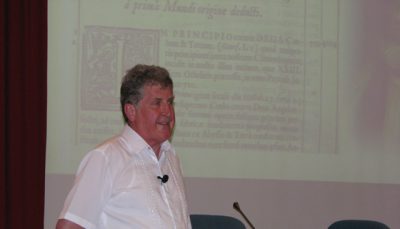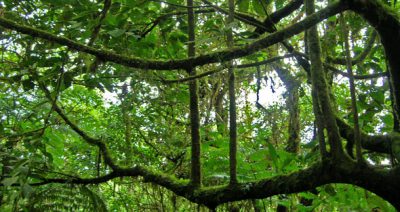TREES AND ‘GOD TALK’
I entered St. Columbans seminary at Dalgan in 1962. The estate in which the seminary was built had extensive woodlands, full of indigenous trees such as oak, hazel, holly, ash, Scots pine, willow, elm and rowan. The woods also contained a number of exotic species, including a number of sturdy Cedars of Lebanon and a few Californian Redwoods. The trees had been planted in the 1820s by General Taylor who had fought alongside Wellington at the Battle of Waterloo. According to local folklore, the woodlands were planted to mark where different British regiments were lined up to do battle with Napoleon.
 During my seven years in the seminary I heard very little that might increase my love or respect for trees. Students were not allowed to walk in the woodlands and we were not even encouraged to give the trees the basic respect of knowing their names. There was one ceremony each year which gave prominence to a tree. It was the beautiful, plaintive melody which was sung during the Exaltation of the Cross on Good Friday. As the celebrant unveiled the Cross, the celebrant sang, Ecce lingnum crucis in quo salus mundi perpendit (Behold the wood of the cross on which hung the saviour of the world). The faithful answered, Venite Adoremus (Come let us adore). The truth is that we were not being asked to focus on the Cross, but on the figure of Christ which was nailed to it. Unfortunately, the natural world did not figure at all in our education for ministry in the 1960s. Little has changed in the intervening four decades in seminaries. Theology and scripture presentations focus almost exclusively on the divine and human realms with little consideration for the rest of creation.
During my seven years in the seminary I heard very little that might increase my love or respect for trees. Students were not allowed to walk in the woodlands and we were not even encouraged to give the trees the basic respect of knowing their names. There was one ceremony each year which gave prominence to a tree. It was the beautiful, plaintive melody which was sung during the Exaltation of the Cross on Good Friday. As the celebrant unveiled the Cross, the celebrant sang, Ecce lingnum crucis in quo salus mundi perpendit (Behold the wood of the cross on which hung the saviour of the world). The faithful answered, Venite Adoremus (Come let us adore). The truth is that we were not being asked to focus on the Cross, but on the figure of Christ which was nailed to it. Unfortunately, the natural world did not figure at all in our education for ministry in the 1960s. Little has changed in the intervening four decades in seminaries. Theology and scripture presentations focus almost exclusively on the divine and human realms with little consideration for the rest of creation.Ministry in Mindanao in the 1970s
Everything changed in September 1972 when the then president, Ferdinand Marcos, declared martial law. Many Church workers, especially those who were involved in promoting social justice, were arrested and some were murdered. For the next 14 years, the energies of Church people were focused on protecting the human rights of the people against both the military and the guerillas as well as promoting social justice. During this time I had little knowledge of or concern for the environment. The only time environmental degradation crossed my mind was when Panguil Bay in northwest Mindanao turned chocolate brown after a day or so of monsoon rains or a typhoon. Even then, my concern was more for the farmers who had lost the precious topsoil than for the integrity of the forest and the well-being of other creatures in the web-of-life.
 Working among the T’boli
Working among the T’boli********
 Rainforests have been plundered right across the globe from the Amazon to the Congo and New Guinea. In 2011 only 60% of Earth’s original tropical forests remain. According to Astill writing in the Economist, “ despite many campaigns by NGOs, vigils and rock concerts for the rainforests, and efforts to buy it, lease it, log it and not log it, the destruction proceeds at a furious clip. In the past decade, the FAO (UN Food and Agriculture Organisation) records show that around 13 million hectares of the world’s forests, an area the size of England, have been lost each year.”
Rainforests have been plundered right across the globe from the Amazon to the Congo and New Guinea. In 2011 only 60% of Earth’s original tropical forests remain. According to Astill writing in the Economist, “ despite many campaigns by NGOs, vigils and rock concerts for the rainforests, and efforts to buy it, lease it, log it and not log it, the destruction proceeds at a furious clip. In the past decade, the FAO (UN Food and Agriculture Organisation) records show that around 13 million hectares of the world’s forests, an area the size of England, have been lost each year.”
To return to trees in the Bible, Jesus uses the mustard tree to illustrate one of his shorter parables. The parable appears in three of the gospels, Matthew (13:31–32), Mark (4:30–32), and Luke (13:18–19). The differences between the text are minor, so it is possible that the tree parables may be derived from the same source. At the most obvious level the parable suggests the growth of the kingdom of God from tiny beginnings to worldwide Church.
The plant referred to here is generally considered to be black mustard, a large annual plant up to 9 feet tall, but growing from a proverbially small seed (this smallness is also used to refer to faith in Matthew (17:20).
Finally, the drama of human history is framed between two very significant trees, In Genesis, the first book of the Bible we find that God planted,” the tree of life and the knowledge of good and evil in the middle of the Garden of Eden” ( Gen. 2:9). In chapter 3, Adam and Eve were admonished “not to eat of the fruit of the tree in the middle of the garden. You must not eat it or touch it under the pain of death.” (Gen. 3.3). The serpent then told Eve that “No, you will not die! God knows in fact that on the day you eat it your eyes will be opened and you will be like gods.” (Gen. 3). Eve and Adam disobeyed God’s command when they ate the fruit from the forbidden tree. As a result, they were expelled from Paradise and found themselves in need of salvation and redemption. Their disobedience also affected their relationship with nature. “Accursed be the soil because of you. With suffering shall you get your food from it every day of your life. It shall yield you brambles and thistles and you shall eat wild plants. With sweat on your brow you shall eat your bread, until you return to the soil, as you were taken from it. For dust you are and to dust you shall return. (Gen. 4: 17-19).
******
 When people talk about forest destruction they are usually referring to what is happening in the tropical forests of the Amazon, the Congo basic, Indonesia and New Guinea. But boreal forests, comprised of spruce, birch, fir and aspen form a band around the northern hemisphere. The places where one finds these forests include Russia, Scandinavia, Finland and Canada. Forest destruction can also be a problem in these areas. For example, in Russia, 55,500 square miles of forests were burned or cut between 2000 and 2005. This represented a massive 14% percent of the total forested area.
When people talk about forest destruction they are usually referring to what is happening in the tropical forests of the Amazon, the Congo basic, Indonesia and New Guinea. But boreal forests, comprised of spruce, birch, fir and aspen form a band around the northern hemisphere. The places where one finds these forests include Russia, Scandinavia, Finland and Canada. Forest destruction can also be a problem in these areas. For example, in Russia, 55,500 square miles of forests were burned or cut between 2000 and 2005. This represented a massive 14% percent of the total forested area.
Many predict that climate change could have a massive impact on the Amazon ecosystems. As often happens in nature, small changes can have drastic consequences. To date, 18% of the Amazon rainforest has been cleared to produce pasture lands for cattle. The Amazon herd now stands at 40 million. The increase in soyabean production has also had a very negative impact on the integrity of the rainforest. A World Bank study carried out in 2010, predicted that a further 2% loss could bring about a “tipping point,” especially in the relatively dry southern or southeastern areas of Brazil. The phenomenon known as ‘dieback’ which is already appearing on the fringes of the forest could spread into the larger forest area.
Promote the Forest Stewardship Council (FSC)
